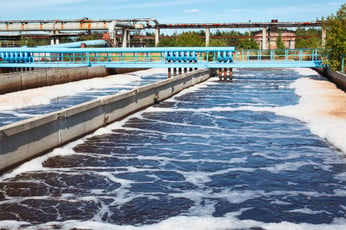By simple definition, wastewater is water that’s been used. Wastewater originates from both residential and commercial sources, including toilets, sinks, showers, bathtubs, washing machines and dishwashers.
.jpg?width=345&name=shutterstock_696806845%20(1).jpg)
While the composition of wastewater is 99.1% water, the other 0.1% contains pathogens—or disease-causing bacteria and viruses; fats, oils and grease; nutrients like phosphorus and nitrogen; biochemical oxygen demand (BOD); and other solids. This 0.1% is why wastewater must be treated before it’s discharged back into the environment.
“Nature has an amazing ability to cope with small amounts of water wastes and pollution, but it would be overwhelmed if we didn't treat the billions of gallons of wastewater and sewage produced every day before releasing it back to the environment,” according to the Institute of Agriculture and and Natural Resources at the University of Nebraska-Lincoln. “Treatment plants reduce pollutants in wastewater to a level nature can handle.”
Wastewater from homes, businesses and other facilities travels through our sewer systems to treatment plants. There, wastewater is cleaned before being released into rivers, streams or other receiving waters, or reused. The goal of wastewater treatment is to speed up natural purification processes. The treatment process is often broken down into three stages.
Primary Wastewater Treatment
The primary treatment stage focuses on sedimentation of solid waste found in the wastewater. The process involves several tanks and filters that work to separate water from contaminants. Once separated, the “sludge” goes into a digester for further processing.
Secondary Wastewater Treatment
The secondary treatment stage uses aerobic biological processes to further purify the wastewater, including biofiltration, aeration or oxidation ponds.

Biofiltration employs sand filters, contact filters or trickling filters to remove any additional sediment from the wastewater. The aeration process involves mixing wastewater with a solution of microorganisms and allowing the mixture to aerate for up to 30 hours. More common in warmer climates, the oxidation pond method uses natural bodies of water like lagoons with native plants, algae, zooplankton and bacteria to pass the wastewater through for a period of time to filter nutrients before it’s retained for several weeks.
Tertiary Wastewater Treatment
Finally, the tertiary stage applies sanitizing processes to remove the water’s impurities and raise its quality to meet specific requirements, whether for reuse or for release into the environment. These processes include sand filtration to remove particulate matter; enhanced biological phosphorus removal; and nitrogen removal using nitrifying bacteria.
Generally, wastewater undergoes rigorous treatment in order to protect both human health and the environment.
“If wastewater is not properly treated, then the environment and human health can be negatively impacted,” the USGS states. “These impacts can include harm to fish and wildlife populations, oxygen depletion, beach closures and other restrictions on recreational water use, restrictions on fish and shellfish harvesting and contamination of drinking water.”
Learn more about the fundamentals of sewer inspection and maintenance by requesting a free copy of Envirosight's Sewer Maintenance 101 guidebook to be mailed to your door:

